Overview
The MS-1 was what Roland refers to as a "phrase sampler" and featured eight rubber pads that triggered individual samples assigned to them. The eight pads were arranged into five banks for a total of 40 sampled sounds - 16 sounds (banks A & B) with the built-in flash memory and up to 24 (banks C, D & E) expanded with the insertion of a PCMCIA memory card. Without a card, only banks A & B could be used. Programming of the MS-1 was possible through the use of a small LCD display and menu-driven settings entered with left and right directional buttons which increased or decreased numerical values and controlled a text editing cursor.
Sample time depended on the sample-rate quality that was selected during recording. The settings were simply called "High", "Standard," "Long-1," or "Long 2." The internal flash memory held approximately 20 seconds on the High setting, or nearly a minute on the Long-2 setting. Typically, Sandisk 2.5, 5 and 10 mega-byte memory cards were used with the MS-1 which increased sampling time and expanded its capabilities.
There were no built-in audio effects, but samples could be pitch controlled, playback start-and-end points could be edited, samples could be truncated allowing the deletion of audio bits that were not desired, samples could be divided and the split parts assigned to separate pads, and samples could be looped and loop start-and-end points could be edited. It also featured MIDI in and out, but no thru.
For recording audio, the MS-1 used left/right RCA jack audio inputs and two microphone jacks. It could sample in either mono or stereo and sampling quality could be reduced to allow more sampling time and the lower the setting, the grittier the digitized sounds became. Audio output was provided through a pair of left/right RCA output jacks and a headphone jack.
The MS-1 also featured a simple, single-track sequencer which triggered only the internal sounds. Up to four sequence patterns could be stored in memory to a total of 900 pad operations.
The machine was also portable and powered either by AC adapter or batteries.
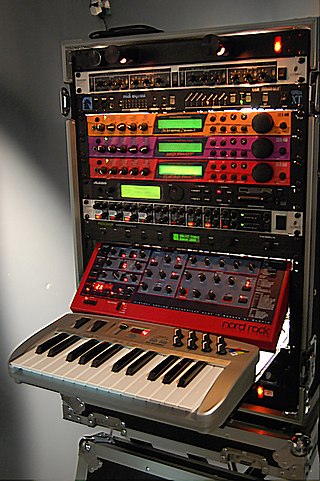
MIDI is a technical standard that describes a communication protocol, digital interface, and electrical connectors that connect a wide variety of electronic musical instruments, computers, and related audio devices for playing, editing, and recording music.

Digital music technology encompasses the use of digital instruments to produce, perform or record music. These instruments vary, including computers, electronic effects units, software, and digital audio equipment. Digital music technology is used in performance, playback, recording, composition, mixing, analysis and editing of music, by professions in all parts of the music industry.

Sound Blaster is a family of sound cards and audio peripherals designed by Creative Technology/Creative Labs of Singapore. The first Sound Blaster card was introduced in 1989.
Akai is a Hong Kong-based manufacturer of consumer electronics. It was established as Akai Electric Company Ltd in Tokyo, Japan, in 1946.
A music workstation is an electronic musical instrument providing the facilities of:

A sampler is an electronic musical instrument that records and plays back samples. Samples may comprise elements such as rhythm, melody, speech, sound effects or longer portions of music.
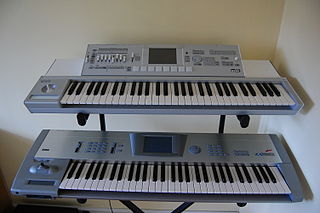
The Korg Triton is a music workstation synthesizer, featuring digital sampling and sequencing, released in 1999. It uses Korg's "HI Synthesis" system and was eventually available in several model variants with numerous upgrade options. The Triton became renowned as a benchmark of keyboard technology, and has been widely featured in music videos and live concerts. At the NAMM Show in 2007, Korg announced the Korg M3 as its successor.

The Ensoniq Performance Sampler (EPS) was one of the first few affordable samplers on the market. It was manufactured from 1988 to 1991 by Ensoniq in Malvern, Pennsylvania, US. The EPS is a 13-bit sampler and replaced the Mirage - widely regarded as the first truly affordable sampling keyboard.

A sound module is an electronic musical instrument without a human-playable interface such as a piano-style musical keyboard. Sound modules have to be operated using an externally connected device, which is often a MIDI controller, of which the most common type is the musical keyboard. Another common way of controlling a sound module is through a sequencer, which is computer hardware or software designed to record and playback control information for sound-generating hardware. Connections between sound modules, controllers, and sequencers are generally made with MIDI, which is a standardized interface designed for this purpose.

The Yamaha Motif is a series of music workstation synthesizers, first released by Yamaha Corporation in August 2001. The Motif replaced the EX series in Yamaha's line-up and was also based on the early Yamaha S series. Other workstations in the same class are the Korg Kronos and the Roland Fantom G. The series' successor is Yamaha Montage, released in 2016, followed up by the Yamaha Montage M in 2023.

The discontinued Roland MC-909 Sampling Groovebox combines the features of a synthesizer, sequencer, and sampler, with extensive hands-on control of both the sound engine and the sequencing flow. It was intended primarily for live performance of pre-programmed patterns consisting of up to 16 tracks of MIDI data. It was released by Roland Corporation on October 8, 2002. This product was announced at the AES Fall Convention in 2002. It is the direct successor to the Roland MC-505 and is the predecessor to the Roland MC-808. Which eventually ended the "Groovebox by year 2010" line of products by Roland which began in the year 1996 with the Original Roland MC-303 groovebox. The Roland Groovebox began again resurgence in the year 2019 with a two new modern & redesign Roland MC-707 GROOVEBOX/Roland MC-101 GROOVEBOX. The Roland MC-909 was developed from the blueprint of Roland's own "Roland Fantom-S Workstation & Roland Fantom-X Workstation" and uses the same structure and operating system, with some differences regarding the Patterns section, not implemented in the Roland Fantom S/X6/X7/X8 Workstation.

The Roland TR-505 rhythm composer is a drum machine and MIDI sequencer released by Roland Corporation in 1986. It hails from the same family of drum machines as the Roland TR-909, TR-808, TR-707, TR-626 and TR-606. The drum kit includes basic rock drum sounds similar to those of the TR-707, plus a complement of Latin-style drum sounds similar to the TR-727.
The Prophet 2000 is a sampler keyboard manufactured by Dave Smith's Sequential Circuits (SCI) and released in 1985. It was the company's first sampler, and, despite its low audio fidelity and technical limitations by modern standards, marked a shift toward affordable samplers with better audio quality than its predecessors. It is also considered to be one of the earliest multitimbral samplers.
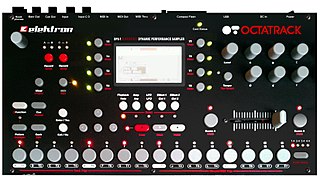
The Octatrack DPS-1 is a digital electronic music instrument made after the Machinedrum UW by Elektron Music Machines. An LCD surrounded by hand controls let the user interact with sampler, step sequencer, mixer, and effect features while stereo audio and MIDI signals are continuously output.
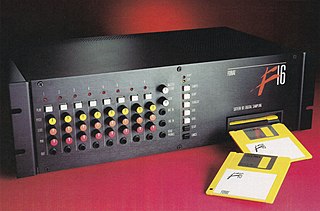
The Forat F16 is the first 16 bit digital sampler optimized for use as an electronic drum module. It dynamically responds to trigger inputs from MIDI and/or audio signals. With a response time of 0.1 milliseconds, the F16 is the fastest audio triggering digital sampler ever sold. It was manufactured by Forat Music and Electronics, introduced in 1987 at a list price of $5200 and was discontinued in 1994. An optional Remote Control and SCSI capability was available for $1385.
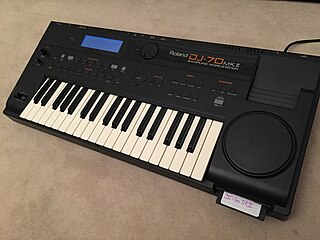
The Roland DJ-70 is a 16-bit linear A/D Conversion & 20-bit linear D/A Conversion sampling workstation and was released in 1992 by Roland Italy.
The HandSonic HPD-20 musical instrument is a hand percussion pad introduced by the Roland Corporation. It was reviewed by digitalDrummer Magazine in 2013. It can be played on its own or used as an addition to a larger drum kit. The dynamic pads are made of rubber to reduce fatigue on the hands. The rear panel includes a mix-in stereo input along with a stereo headphone output and two quarter inch jacks.
The Roland SP-808 GrooveSampler and SP-808EX/E-Mix Studio are both discontinued workstations, which function as digital samplers, synthesizers, and music sequencers. The digital samplers are a part of the long line of both Roland Corporation's and Boss Corporation's Groove Gear, which includes the more popular and successful Boss SP-303 and Roland SP-404 versions.
The Roland DDR-30 "Alpha Drum" is a digital PCM drum module built by Roland, in early 1985. It was introduced during 1985 Summer NAMM industry trade show in New Orleans.















